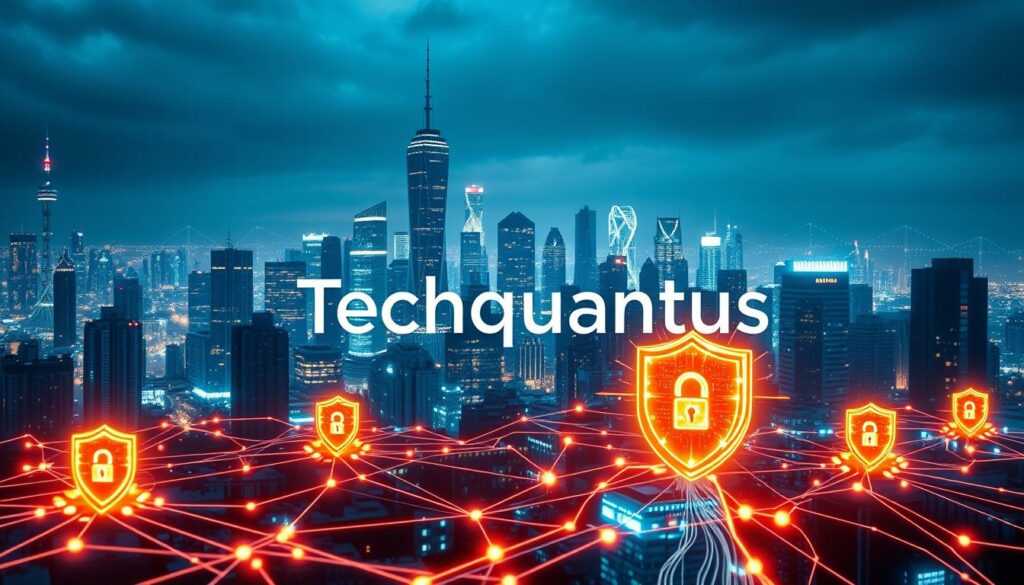Did you know that by 2030, quantum computers could break encryption methods that protect sensitive data now? This fact shows how quantum computing is changing cybersecurity. Quantum threats are getting bigger and could change how we protect data. But, they also bring new chances for secure communication and data protection.
Understanding these changes is key for everyone. How you adapt will help protect against quantum threats. We’ll look into how quantum computing affects cybersecurity and what steps you can take to keep your data safe. Stay with us to learn how to handle these changes, which will shape how we protect sensitive information in the future. For more info, check out this systematic review on how hormones affect pregnancy outcomes.
Key Takeaways
- The rise of quantum computing poses significant risks to traditional encryption methods.
- Quantum threats can revolutionize data protection strategies.
- Adapting to the quantum landscape is essential for effective cybersecurity.
- Opportunities arise from quantum advancements that can enhance secure communication.
- Understanding the implications of quantum threats is crucial for safeguarding sensitive data.
Understanding the Basics of Quantum Computing
Quantum Computing Basics are built on quantum mechanics. This changes how computers work compared to old ones. Old computers use bits, which can only be a 0 or a 1. But, quantum bits, or qubits, can be many states at once thanks to superposition. This lets quantum computers handle lots of info way faster.
Entanglement is another key part of quantum mechanics. It means the state of one qubit affects another, no matter how far apart they are. This special connection helps quantum systems do complex tasks that old computers can’t.
Knowing these ideas is key to seeing how quantum computing could change things like cybersecurity. As you learn more about Quantum Computing Basics, you’ll see how qubits work together and lead to new tech advances.
How Quantum Computing Works in Comparison to Classical Computers
Computing has two main types: Quantum and Classical. The key difference lies in how they process information. Classical computers use bits, which can only be a 0 or a 1. This limits how complex problems they can solve.
Quantum computers use qubits, which can be many states at once. This lets them do many calculations at once. For example, they can solve complex problems much faster than classical computers.
Let’s look at how fast quantum computers are compared to classical ones:
| Type of Computing | Processing Unit | Capability |
|---|---|---|
| Classical Computing | Bit | Handles one calculation at a time |
| Quantum Computing | Qubit | Processes multiple calculations simultaneously |
Quantum computers can solve complex problems that classical ones can’t. This includes things like optimizing processes and breaking certain codes. As scientists learn more about qubits, we see new ways they could change many fields. This technology also makes us think about the future of keeping data safe.
The Evolving Landscape of Cybersecurity Threats
The digital era has brought a big change in how we deal with cybersecurity threats. As companies go online more, they face more risks of cyberattacks. A study by ISSA and ESG found a 63% jump in cyber attacks during the COVID-19 pandemic. This shows how connected we are makes us vulnerable.
Cybersecurity experts are often swamped by the many threats out there. A survey by Imperva showed that 55% of IT pros get over 10,000 threats a day. Nearly a third deal with more than a million alerts. This makes it hard to spot the real threats.
About 53% of those surveyed struggle to tell serious threats from the noise. Data breaches are a big problem, highlighting the need for strong cybersecurity. The Target breach in 2013 made people talk about how companies should handle cyber risks better.
Now, threats go beyond just hacking. The PEAKLIGHT dropper malware is a good example. It can infect Windows systems and avoid being caught. It spreads through fake pirated files and downloads more malware.
As cyber threats change, companies must stay alert and act fast to protect their data. Knowing about the latest threats, like data breaches and malware, helps in fighting these challenges.
| Year | Increased Cyber Attacks (%) | Daily Threats Reported | Critical Incident Identification Difficulty (%) |
|---|---|---|---|
| 2020 | 63 | 10,000+ (55% of IT Professionals) | 53 |
| 2013 (Target Breach) | N/A | N/A | N/A |
| 2021 | N/A | 1,000,000+ (27% of IT Professionals) | N/A |
Quantum Computing: Threat or Opportunity for Cybersecurity?
Quantum computing changes the game in cybersecurity, bringing both risks and chances. It threatens traditional encryption methods. Quantum computers can break many encryption types, like RSA and ECC, fast. This means sensitive data could be at risk, making cybersecurity threats worse.
But, quantum tech also brings new ways to keep information safe. For example, Quantum Key Distribution (QKD) could change how we communicate securely. QKD uses quantum mechanics to detect any data theft, offering top-notch security.
It’s key to see how quantum computing’s threats and chances will shape cybersecurity’s future. As tech changes, knowing how to use quantum tech safely is crucial. The debate on quantum computing’s role in cybersecurity will keep evolving, affecting digital security for a long time.
Potential Risks Quantum Computing Poses to Current Encryption Methods
Quantum computing is a big challenge for current encryption methods we use today. Techniques like RSA and ECC are at risk from quantum computing. Quantum algorithms, such as Shor’s, can break these methods easily, posing big cybersecurity risks to organizations.
As quantum tech gets better, we need new cryptography solutions. Companies using old security methods could lose sensitive data to quantum attacks. Important areas like finance, healthcare, and government need to check their security to fight these threats.
Here’s a table showing how quantum computing affects current encryption:
| Encryption Method | Type | Vulnerability to Quantum Attacks | Recommended Quantum-Safe Alternatives |
|---|---|---|---|
| RSA | Public Key | High | Lattice-based Cryptography |
| ECC | Public Key | High | Multivariate Quadratic Equations |
| AES-256 | Symmetric Key | Moderate | Increased Key Length Recommended |
With these risks, companies need to know about the risks of quantum computing. They should work together to find new ways to keep data safe. Planning and investing in better cryptography is key in this quantum age. For more info and strategies, check out TechQuantus.
Strategies for Protecting Data in a Quantum World
In today’s fast-changing digital world, companies need strong Data Protection Strategies to keep their data safe from quantum threats. Moving to quantum-resistant algorithms is key for Quantum Security. This means changing encryption methods that could be broken by powerful quantum computers.
Companies should use a multi-layered Cyber Defense plan. This plan needs different protective steps to make a strong wall against possible attacks. Important parts of this plan include:
- Regular Security Audits: Check and update security plans often to keep up with new quantum risks.
- Employee Training: Teach staff about cybersecurity and how quantum tech affects data safety.
- Advanced Threat Detection: Use AI tools to find and stop threats early.
- Data Minimization: Keep personal data to a minimum to lessen risk if there’s a breach.
Creating a plan to add quantum threat defense to your cybersecurity is also a good idea. This means working together between IT teams and cybersecurity experts to make sure all data protection is covered. By getting ready for quantum computing challenges, your company can stay strong in Cyber Defense.

The Role of Quantum Key Distribution (QKD) in Enhancing Security
Quantum Key Distribution (QKD) is changing how we keep data safe. It uses quantum cryptography to send encryption keys securely. This makes it hard for hackers to tap into these keys.
The BB84 protocol from 1984 was a big step forward in QKD. It helped pave the way for better security methods. In the 2000s, Quantum Secret Sharing (QSS) made secure communication even better. Then, Twin-Field QKD (TF-QKD) came along in the 2010s, making QKD systems stronger.
QKD relies on the Quantum Bit Error Rate (QBER) to spot potential hackers. Knowing this rate is key to keeping data safe. As QKD grows, so does the need for secure key sizes, which is important for security.
QKD is now being used in many areas, like smart grids and cloud computing. It helps keep data safe in these networks. This technology is also being used to protect IoT devices in smart grids.
QKD has led to new solutions like Quantum Bridge Technologies’ DSKE technology. This tech offers a new way to share keys securely. It doesn’t use traditional cryptography methods.
Investments in QKD are growing, showing its importance in cybersecurity. Governments in Europe and North America are working together to make QKD standards. This shows how crucial QKD is for keeping data safe.
| QKD Development Milestone | Year Introduced | Significance |
|---|---|---|
| BB84 Protocol | 1984 | First practical QKD protocol. |
| Quantum Secret Sharing (QSS) | Early 2000s | Introduced secure information sharing. |
| Twin-Field Quantum Key Distribution (TF-QKD) | Late 2010s | Enhanced key distribution robustness. |
Future Technologies: Preparing for a Post-Quantum Cybersecurity Era
The rise of quantum computing is a big deal for the Future of Technology. As we move forward, having strong plans for Post-Quantum Cybersecurity is crucial. New tech is coming that will work with quantum and keep our data safe. Learning about these new tools will help you get ready for a future where cybersecurity will keep changing with tech.
Emerging Technologies are key in making the world of Next-Generation Security better. Think of new encryption that can’t be broken by quantum computers, secure ways to work together, and better ways to prove who you are. Using these, you can make your digital world safer.
Learning never stops in the world of cybersecurity. Experts need to get up to speed on quantum and how it changes security. Courses on Post-Quantum Cybersecurity will help you stay ahead. Working together with others in the field also leads to new ideas and better solutions.
As quantum tech gets better, being proactive is key. Your company should put money into finding and fixing weak spots and using the latest tech. Being ready to change is important in the Future of Technology, so your security can keep up with new threats.

To get ready for a Post-Quantum Cybersecurity world, we need to embrace new ideas and be open to change. Having the right knowledge and tools will help you keep up with Next-Generation Security needs. The path ahead requires us to be watchful and have a clear vision.
Conclusion
Quantum computing is changing the game in cybersecurity, bringing both risks and chances. It challenges our current encryption but also opens doors to new ways to protect data. Understanding this shift is key to making smart cybersecurity plans for the future.
It’s crucial to update your data protection plans for quantum computing. Staying up-to-date with tech changes helps you protect against new threats. Combining old and new tech can make your security stronger, ready for whatever comes next.
Quantum computing offers big chances, but you need to be proactive. As threats change, learning and adapting is vital. This approach will help you build strong cybersecurity that can face the future’s challenges.
FAQ
What is quantum computing?
Quantum computing uses quantum mechanics to process information in new ways. It uses quantum bits, or qubits, which can handle information differently than regular bits.
How does quantum computing impact cybersecurity?
Quantum computing brings both risks and chances for cybersecurity. It can break some encryption methods but also helps create new, stronger security tools like Quantum Key Distribution (QKD).
What are qubits, and how do they differ from classical bits?
Qubits are the basic units of quantum computing. They can be in more than one state at once, unlike classical bits which are only 0 or 1. This lets quantum computers work faster and more efficiently.
What encryption methods are vulnerable to quantum threats?
Encryption methods like RSA and ECC are at risk from quantum threats. Quantum computers can break these with algorithms like Shor’s. This means we need to use new, quantum-safe encryption.
What is Quantum Key Distribution (QKD)?
Quantum Key Distribution uses quantum mechanics to send secure encryption keys. It’s very hard to tap into, making it a top way to keep data safe.
How can organizations protect their data against quantum threats?
To protect data, organizations should use quantum-safe algorithms and a strong security plan. They should also include quantum threat defense in their strategies.
Why is it important to understand the evolving landscape of cybersecurity threats?
Knowing about new cybersecurity threats, especially those from quantum tech, helps us get ready for cyberattacks and data breaches. It’s key in today’s digital world.
What should businesses do to prepare for a post-quantum cybersecurity era?
Businesses should keep learning, adapting, and innovating in cybersecurity. They should use new tech that works with quantum computing to keep their data safe.
Source Links
- Thermoelectric Performance of Non-Stoichiometric Permingeatite Cu3+mSbSe4
- Adiponectin and Leptin during Pregnancy: A Systematic Review of Their Association with Pregnancy Disorders, Fetal Growth and Placental Function
- Experiments demonstrates chiral quantum heating and cooling with an optically controlled ion
- Researcher discusses a new type of collective interference effect
- A Practical Guide to Risk-Based Cybersecurity Reporting.pdf
- PEAKLIGHT Dropper: Hackers Target Windows With Downloads
- Influence of Tea Polyphenols, Chitosan, and Melatonin as the Eco-Friendly Post-Harvest Treatments on the Vase Life of the Cut Chrysanthemum ‘Pingpong’ Group
- Global stocks slide as Microsoft outage wreaks havoc
- Evaluating Environmental Sustainability: The Role of Agriculture and Renewable Energy in South Korea
- Algorithms of Cross-Domain Redundancy Management for Resilient of Dual-Priority Critical Communication Systems
- A Novel Method of Secured Data Distribution Using Sharding Zkp and Zero Trust Architecture in Blockchain Multi Cloud Environment
- Performance Evaluation of CF-MMIMO Wireless Systems Using Dynamic Mode Decomposition
- Top 10 Latest Trends in AI Development For 2024
- No match, but still access to the data: dating apps spill personal data
- IDC: 59% of Asia/Pacific Enterprises Targeted by Ransomware in 2023
- Comparative Study: The Emerging of Quantum Cryptography
- Partnership to advance industry-first quantum-safe networking
- Nutritional Management of Pediatric Gastrointestinal Motility Disorders
- Validity and Reliability of Movesense HR+ ECG Measurements for High-Intensity Running and Cycling
- Understanding University Students’ Foreign Language Learning Attitudes: An Analysis Based on Stereotypes
- My Guide to Understanding Data Centre Architecture: Core Components Every IT Pro Should Know
- Wazuh Home Network Setup: A Step-by-Step Guide
- Quantum Computers Decrypting Blockchain: The Risks and Implications
- Wazuh: Enterprise-Grade Security for Your Business
- Wazuh for Beginners: A Comprehensive Guide
Related posts:
 How Quantum Cryptography is Transforming Data Security
How Quantum Cryptography is Transforming Data Security
 The Intersection of Quantum Computing and Blockchain Technology
The Intersection of Quantum Computing and Blockchain Technology
 Quantum Algorithms: A Deep Dive into Shor’s Algorithm
Quantum Algorithms: A Deep Dive into Shor’s Algorithm
 IAM Introduction: Identity Access Management Basics
IAM Introduction: Identity Access Management Basics
 Access Control Concepts: Safeguarding Systems and Data in Cybersecurity
Access Control Concepts: Safeguarding Systems and Data in Cybersecurity
 How to Secure Your Home Network: Best Practices
How to Secure Your Home Network: Best Practices
